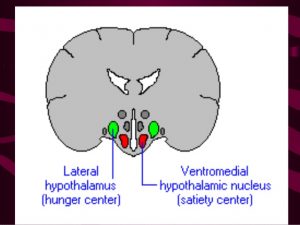We all have heard stories about cats stealing lunch meat from their owner’s sandwich or dogs “counter surfing” to find that delicious and warm fresh loaf of bread. Sometimes the pets are simply food motivated and naughty. But – more often than naught – there is a medical reason for their increased hunger. Increased hunger is called polyphagia, and this week I’ve dedicated some time to sharing potential causes of this common clinical sign. I hope you find the information interesting. Happy reading!
Polyphagia – What controls hunger?
To best understand polyphagia, one should have a basic understanding of hunger and satiety. Several factors control a pet’s food intake, particularly:
- Gastrointestinal events
- Environmental influences
- Central nervous system
The hypothalamus in the brain receives input from both the environment and internal signals (i.e.: hormones) to control hunger and satiety. Specific locations in the hypothalamus have different jobs. The lateral hypothalamic nuclei are the “feeding centers” while the ventromedial nuclei are the “satiety” centers. The former is always active unless inhibited by signals received after a meal while stimulation of the latter causes a refusal to eat. Other areas of the brain – including the brainstem, nucleus of the solitary tract, and area postrema play minor and coordinating roles in hunger and satiety.
The gastrointestinal tract plays a major role in feeding habits of pets. Factors such as stomach distention, how quickly the stomach empties, different hormones, and nutrient absorption all effect hunger and satiety. Some hormones – leptin, insulin, glucagon, pancreatic peptide, and cholecystokinin – reduce signals to the brain that trigger hunger. Conversely, other hormones – namely ghrelin – stimulate eating. Similarly, decreased concentrations of other nutrients like glucose and amino acids trigger appetite. When metabolism is increased for any reason, nutrients are used more by the body, and the body responds through stimulation of eating.
Polyphagia – What causes it?
By definition, polyphagia is food intake that exceeds normal caloric intake. This clinical sign is defined as either primary or secondary. Primary polyphagia is caused by damage or dysfunction of the central nervous system. Common causes include brain trauma, infection in the central nervous system, and a mass lesion (i.e.: cancerous tumor). In comparison, secondary polyphagia is the result of a systemic disorder that affects the central nervous system. Secondary polyphagia is much more common in dogs and cats, and common systemic problems that cause increased caloric intake include:
- Hyperthyroidism
- Diabetes mellitus (dogs vs. cats)
- Exocrine pancreatic insufficiency
- Inflammatory bowel disease
- Protein-losing enteropathies
- Megaesophagus
- Hypoglycemia
- Hyperadrenocorticism (Cushing’s disease)
- Liver shunting disorders
- Pregnancy
Polyphagia – What does it look like?
Recognizing polyphagia is relatively straightforward. It is typically quite obvious when a pet is eating more than normal since pet parents are obviously knowledgeable of their fur baby’s eating habits.
Polyphagia – How is it diagnosed?
Again, confirming polyphagia is easy. Figuring out what is causing it can be much more challenging. Your family veterinary will ask you a lot of questions about your pet’s medical history, including diet, medications, and weight history. Please be sure to answer all of their questions as thoroughly as possible. The doctor will also perform complete physical examination, looking for clues about the underlying cause of a pet’s polyphagia. Veterinarians should perform initial blood and urine tests to screen for underlying disorders. Pet parents may find it helpful to partner with a board-certified veterinary internal medicine specialist to develop a cost-effective and logical diagnostic plan.
Polyphagia – How is it treated?
Treatment of polyphagia depends entirely on the underlying cause of it in the first place. Treatment for diabetes mellitus is very different than treatment for Cushing’s disease. With a definitive diagnosis, your family veterinarian will be able to counsel you regarding the most effective treatment for your fur baby. For challenging cases of polyphagia, pet parents are encouraged to partner with a board-certified veterinary internal medicine specialist to devise an effective treatment plan.
The take-away message about polyphagia in dogs & cats…
Polyphagia or increased caloric intake is reasonably common in dogs and cats. Systemic disorders are the most common causes. With early identification and effective management, most pets are able to lead high-quality and highly functional happy lives.
To find a board-certified veterinary internal medicine specialist, please visit the American College of Veterinary Internal Medicine.
Wishing you wet-nosed kisses,
CriticalCareDVM


